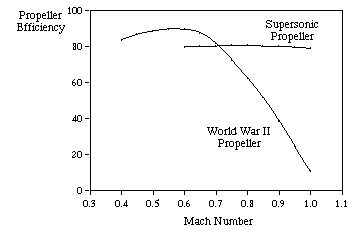Short answer:
- Turbofans need supersonic speed at the fan blade tips to create their high thrust.
- Turbofans can tolerate supersonic speeds because the intake creates constant flow conditions irrespective of flight speed.
- Efficiency for propellers and fan blades is highest at subsonic flow conditions.
- Propellers can turn at supersonic speeds, but since flow conditions are less controlled, the penalty for doing so is much higher than the penalty for a fan.
Explanation
It is a bad thing to have supersonic fan blade tips, just like supersonic propeller tips are best avoided. But in turbofans it is a price worth paying, because the faster tip velocity means higher dynamic pressure, and the pressure difference between both sides of the fan blade grows with the square of their velocity. This makes the high thrust levels of modern turbofans possible.

Propeller efficiency over speed (picture source). The plot for fan blades would look not much different. The very thin, uncambered airfoil of a supersonic propeller and the added wave drag lower the maximum efficiency, but hold efficiency up into supersonic air speeds.
Note that the propeller on the XF-84H Thunderscreech did move at supersonic speed. There is nothing inherent in propellers which prevents their tips from moving faster than the speed of sound. On the other hand, the big diameter of a prop requires proportionally more torque to keep the prop rotating against the drag from the supersonic tips. Thus, a fan engine requires less torque per blade to reach supersonic tip speeds on the fan blades.
Also, the shroud of a turbofan engine helps a lot to make the noise from supersonic tips manageable. The XF-84H's noise made people literally sick. But there is more to it: @FreeMan encouraged me with his comment to dive a little deeper.
A supersonic propeller will work well when the direction of flow at every station along the propeller blade is about equal to the local airfoil chord. Since the blade is uncambered, this means that the change in local flow direction at the leading edge can be minimized to the amount which is required to create the desired thrust. But to be able to fulfill this condition you need to match your propeller speed to the flight speed and twist distribution. Also, the angle of attack must be compensated for by sviveling this propeller axis into the direction of flight. It will have no p-factor, but can run at only one speed for a given flight speed.
Contrast this with a turbofan: The intake makes sure that the flow speed and direction at the face of the fan is the same no matter what the flight speed is. This is done by the pressure field in and around the intake which will spill excess air overboard at high speed or suck extra air in from the sides at low speed. In the fan you can indeed match the local angle of incidence to the airspeed so the fan will work well over its design range.
Generally, a fully subsonic fan would be more efficient. But then the diameter would need to be as large as that of big turboprop engines, and the shroud would become impossibly heavy and produce too much drag. The high dynamic pressure on the fan blades is needed to produce the thrust with the relatively small diameter of a turbofan.

